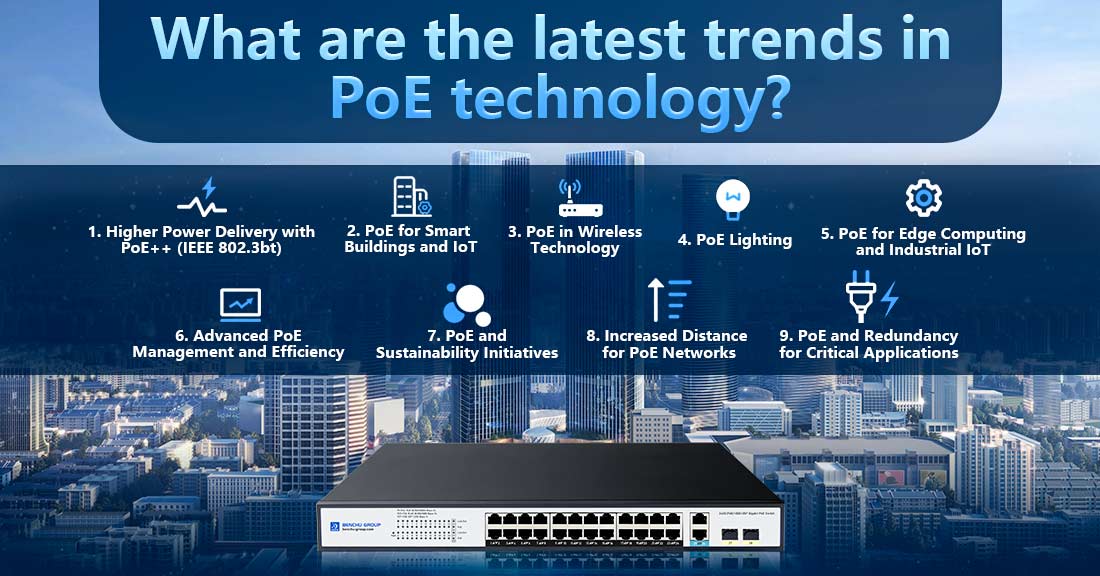
The latest trends in Power over Ethernet (PoE) technology reflect advancements in power capacity, efficiency, and the expanding range of applications. These trends are shaping how PoE is used in both enterprise and industrial settings, driven by the growing demand for smart devices and IoT solutions. Here are some key trends in PoE technology:
1. Higher Power Delivery with PoE++ (IEEE 802.3bt)
PoE++ Standard: The introduction of PoE++ (IEEE 802.3bt) enables power delivery of up to 100 watts per port, significantly higher than the 15.4 watts (PoE) and 30 watts (PoE+) of earlier standards. This is ideal for powering high-demand devices such as:
--- 4K IP cameras with advanced features like PTZ (pan-tilt-zoom).
--- LED lighting systems.
--- High-performance wireless access points (Wi-Fi 6/6E).
--- Digital signage, video conferencing systems, and other power-hungry devices.
Impact: Higher power capabilities allow PoE to support a broader range of devices, including larger and more complex smart building systems and industrial equipment, expanding its application across different sectors.
2. PoE for Smart Buildings and IoT
Smart Building Infrastructure: PoE is increasingly being integrated into smart building ecosystems, where a single Ethernet cable can power and network a variety of devices such as security cameras, lighting, HVAC systems, and sensors. This integration improves energy efficiency, reduces installation costs, and simplifies network management.
IoT Devices: With more IoT devices deployed in offices and industrial environments, PoE is playing a crucial role in powering and connecting these devices, offering reliable power and data transmission over a single cable. Examples include smart thermostats, access control systems, and environmental sensors.
3. PoE in Wireless Technology
Wi-Fi 6/6E Access Points: The latest Wi-Fi 6 and Wi-Fi 6E access points require more power to deliver higher throughput and coverage. PoE++ is ideal for supporting these high-performance wireless devices without needing separate power outlets, simplifying the deployment of dense Wi-Fi networks.
5G Small Cell Deployments: PoE is being used in the deployment of 5G small cells, which require power and data transmission. PoE simplifies the installation of small cells in urban areas or crowded environments by reducing the need for additional power infrastructure.
4. PoE Lighting
PoE Lighting Systems: LED lighting powered by PoE is an emerging trend in smart building design. PoE allows for centralized control of lighting systems, enabling better energy efficiency, remote management, and integration with other smart systems like occupancy sensors. PoE lighting also eliminates the need for separate electrical wiring, making installation easier and more cost-effective.
Integration with Building Automation: PoE lighting can be integrated into broader building automation systems, providing features like daylight harvesting, automated dimming, and energy monitoring.
5. PoE for Edge Computing and Industrial IoT
Edge Computing Devices: As edge computing grows, PoE is being used to power and connect devices that process data closer to the source (e.g., cameras, sensors). This reduces latency and improves the performance of real-time applications like video analytics and industrial automation.
Industrial PoE: In industrial environments, PoE is increasingly used for IP cameras, sensors, and automation equipment. PoE’s ability to provide reliable power in harsh conditions, combined with its simplicity, makes it an attractive option for smart manufacturing and industrial IoT (IIoT) deployments.
6. Advanced PoE Management and Efficiency
Energy-Efficient PoE: There is a growing focus on energy efficiency in PoE switches and devices. Modern PoE switches often include features like power scheduling, where devices are powered down during off-hours to save energy, and dynamic power allocation, where power is distributed only when needed.
Smart Power Management: Advanced PoE switches now offer intelligent power management features that monitor power usage, automatically prioritize critical devices, and provide remote management tools. This improves overall network reliability and energy consumption.
7. PoE and Sustainability Initiatives
Green Building Certifications: With increasing attention to sustainability and energy efficiency, PoE-powered smart systems are helping organizations achieve certifications like LEED (Leadership in Energy and Environmental Design). PoE’s ability to reduce energy consumption and streamline infrastructure makes it attractive for sustainable building projects.
Reducing Carbon Footprint: By combining power and data in a single cable, PoE reduces the need for extensive electrical wiring and power outlets, cutting down on material costs and labor, and contributing to lower carbon emissions during construction.
8. Increased Distance for PoE Networks
PoE Extenders: PoE networks are typically limited to 100 meters (328 feet) in cable length. However, PoE extenders are increasingly used to extend the reach of PoE networks up to 500 meters (1640 feet) or more, allowing devices to be deployed over greater distances without losing power or data integrity.
9. PoE and Redundancy for Critical Applications
Redundant Power Supply: To improve reliability, especially in mission-critical applications like surveillance, PoE switches now come with redundant power supply (RPS) features. This ensures that PoE devices, such as security cameras, remain operational even if the primary power source fails.
Backup Power with PoE: Many organizations are combining PoE with uninterruptible power supplies (UPS) to ensure continuous power for essential devices during power outages, increasing network uptime and reliability.
Summary of Key Trends
--- Higher power delivery with PoE++ (up to 100W per port) is expanding the range of devices that PoE can support.
--- PoE is central to smart building infrastructure and IoT deployments, powering devices like sensors, lighting, and HVAC systems.
--- Wi-Fi 6/6E access points and 5G small cells are increasingly powered by PoE, reducing the need for additional power infrastructure.
--- PoE lighting is becoming more prevalent in smart building design, improving energy efficiency and control.
--- Edge computing and industrial IoT devices are being powered by PoE to reduce latency and simplify installation.
--- Advanced power management features in PoE switches are improving energy efficiency and network reliability.
--- Sustainability initiatives are driving PoE adoption for reducing energy consumption and infrastructure costs.
These trends reflect PoE's growing role as a versatile, scalable, and energy-efficient solution for modern network infrastructure.